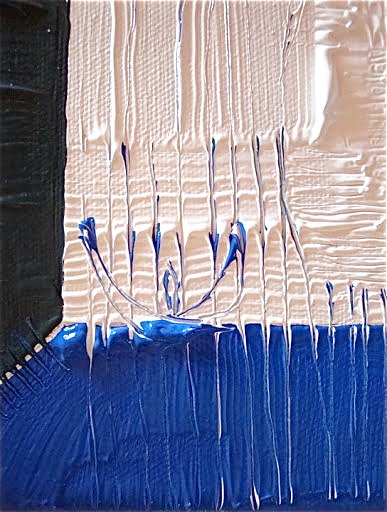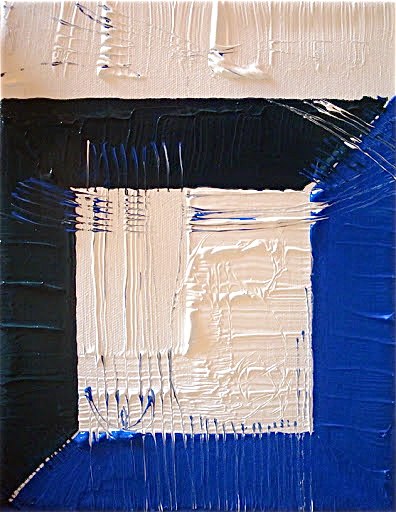Yesterday’s Painting
May 2010

Second, I choose color. I’d been working with dark colors so I choose white for the center just to make a change.
Third, I develop the texture as I apply the color, moving the brush from the centerline to the edge of the inner square. The sun is up now and bathes each brush stroke in low angle warm light; shadows form cast from the liquid thickness of the paint.
Fourth, I choose a color for the outer square. I choose blue, mostly arbitrarily and mix it with the remaining white on my mixing paper. I add a bit of mixing media to thin the mix.
I apply this color to two edges of the outer square, mitering the corners as I go. The mitering comes to me as I look at the diagonals used to draw the square on the canvas.
Fifth, I run out of the blue white mix. This happens often, and since I don’t record what proportions I used to make what color, I don’t even try to match it, but take it as a sign that I should change colors.
So both the mitered corners and the two-color outer square comes from me trying to hear the painting as I paint it. It’s like seeing every point of resistance, every problem as a proposition from the work to me. There is always a choice, to listen or not, and some days I don’t listen, but I did yesterday and thought about another color.
Sixth, I chose the yellow ochre thinking that when combined with the blue, I’d get a nice green. This painting and a few of my recent ones are kind of “buildups” of color. So in this one, I start with white for the center element, then add blue to the remaining white on the mixing sheet to get the outer square miter on two sides, then add ochre to the blue to make a green for the other two sides of the outer square. Again, no mystery or intent, just thought it’d be pretty and that by always linking two colors in the mix, that the painting would hold together a bit better.
Seventh, I start applying the green from the miters outward, remembering that I had made a mistake on an earlier painting; and didn’t quite merge the two colors, but let the white canvas show through from below. It really brings your eye to the point where two colors don’t quite meet. So I leave a sliver of canvas visible and paint from the miter outwards and fill the remaining outer square.
Eighth, I step back and look at what is on the canvas, thinking about some yogurt for breakfast, something isn’t right. the center white square is too independent of the outer square pieces. I start to get disillusioned with the piece and go for the yogurt. A piece of florist wire is laying on the counter; it’s a castoff bit formed when I was thinking I’d hold the lily up off the bottom of the cylinder of the tabletop pond. I open the yogurt, the foil top tears in half and I dig in the drawer for a spoon to get the rest of the foil off. I’d put the yogurt down on the counter and it made the wire twist up and catch a bit of sun. I pick the remaining foil from the yogurt to open it, grab the spoon, lift the yogurt and the wire falls back.
I’m seeing the wire, thin, a bit curved lay on the tile countertop. The tile is chunky and the contrast with the wire is strong in both the thinness of it, its curve against the grid of the tiles, and its green color against the beige countertop. I pick it up and carry it with the yogurt back to the painting. I’m standing over the painting, holding the wire, spoon, and yogurt, go to fill the spoon and drop the wire into the paint. It lays there for a quick expletive and I snatch it up. As I stand looking at the damage of the wire in the thick paint, I see that it has left a track across the high parts of the brush strokes. The track is thin, the paint is thick, and as I removed the wire, a bit of blue has been dragged into the white.
I’m thinking of how friendships begin now as I look at the blue dragged into the white; I don’t know why, but I see the wisp of blue extending into the white as the first gesture from one to another. We make these gestures sometimes out of politeness, sometimes out of compassion, sometimes as an entree to meet someone and occasionally, each little wisp of effort takes hold, a dialog of little efforts exchange between two people and even more rarely, become a mesh or a netting of efforts that become the shared experiences and gestures that hold friends together. Mostly here I was thinking about when I first met my friend Rick in high school, from that first gym class, we worked on cars, met other friends, took days off from high school; and as a group (Nancy, Diane, John and John) we cooked, saw the auto show, went to the Indiana dunes, all sorts of things that bit by bit, wisp by wisp, bound us together in friendship. Mostly, I’m thinking of this because Nancy and I found each other again on facebook recently and I’ve been trying to think of how to describe my life since we fell out of touch (the wisps snap when you don’t maintain them) during college.
So I pick up the wire and begin dragging thin bits of color from the edge square into the white center square, bits of color across the open white miter joint, imagining each wisp will bind the parts together just a bit more firmly. After scratching the wire through the paint in rectilinear patterns, I sweep it across the canvas, and curl it into the sweep at the end.

All this is to say, the paintings I do begin simply, and I’m looking for something to catch me, to speak to me, like walking through a garden. I’m trying to slow my mind down enough to let something pop into my eyes and reach me. Each time that happens, I’m outside of myself, forgetting my calendar, forgetting the past, it helps me to enjoy that moment when the sun is low, the birds are noisy, and the yogurt is still cold.
I enjoy the memories and thoughts that this process brings to me, and somedays, my mind is already too busy when my feet touch the floor to have this dialogue with the work. But somedays it works.

Thanks for helping me think of this, have a great day, be good to each other, listen to your work!
enough





